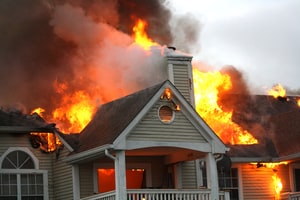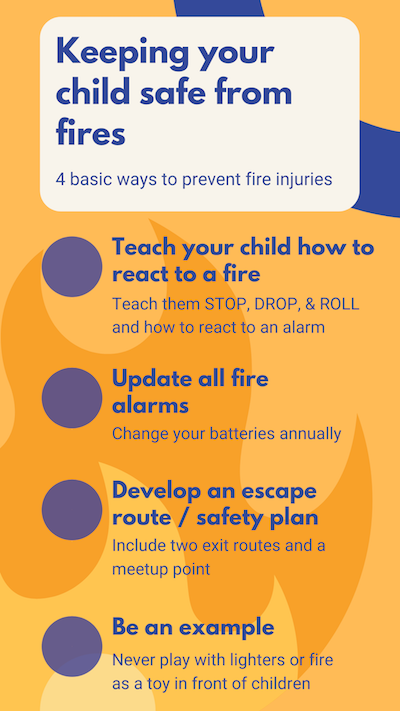Child Fire Safety
 As a parent, the idea of a fire coming into contract with your child is terrifying. Many adults do not know how to act safely when faced with an active fire, let alone with a child. On top of that, many parents feel like there's a very slim chance that a house fire will occur. This is the kind of thinking that gets people hurt. Parents need to be prepared for unpredictable situations and should be armed with a plan each time. Learning more about the dangers and causes of a blaze, as well as developing a family escape plan, is the best way to prevent any harm and create ease of mind.
As a parent, the idea of a fire coming into contract with your child is terrifying. Many adults do not know how to act safely when faced with an active fire, let alone with a child. On top of that, many parents feel like there's a very slim chance that a house fire will occur. This is the kind of thinking that gets people hurt. Parents need to be prepared for unpredictable situations and should be armed with a plan each time. Learning more about the dangers and causes of a blaze, as well as developing a family escape plan, is the best way to prevent any harm and create ease of mind.
Statistics show that the residential home is the number one source of fire-related deaths and injuries to children. Most of these devastating fires are from oversight while cooking or smoking a cigarette.
As a parent, you understand the danger that a fire can present. A child is unable to understand the long-term consequences fire can have. Whether it is a genuine curiosity of how fire works or is purely by accident, children have caused devastation from playing with fires. The Red Cross reports that an estimated, 300 people are killed and $280 million in property is destroyed each year as the result of children playing with fire.
How you approach the topic of fire safety and the kind of safety plan you create is dependent on the age of your child. The younger the child is, the less able he/she is to act independently. Every year 500 children, ages 14 years and younger are killed by a fire and more than 50% of children ages 5 and younger die while asleep during the fire. Any fire safety plan should accommodate around the age of your child. While an active fire is occurring, it's easy for children and adults to get flustered and react from adrenaline, forgetting the basics. It is important to familiarize your child with the following tips so they can feel confident.
What Should You Teach Your Kids?
- If your child is on fire, teach them to: STOP, DROP, and ROLL.
- Teach them not to be afraid of firefighters. They are there to help!
- When you test your fire alarm, have your kids around to hear it. This will familiarize them with the sound and let them know what it means if it goes off.
- Teach your kids how to get low, crawl, and cover their mouths with their hand or fabric to prevent smoke from getting in their lungs.
- Teach your kids how to identify a hot doorknob. A hot doorknob signals that there is a fire on the other side and is not a safe enter/exit.
- Teach your kids how to open a window and use a safety ladder (if you have one)
- Remind your kids to turn off and unplug any heat-producing products, such as curling irons, stoves, space heaters, etc.
- Be an example: Children are impressionable and may want to imitate what they see you or another family member do. Never play with fire or lighters as a toy in front of your children. Demonstrate the proper way to handle fire.
- Fire alarms: If you don't already have a fire alarm in every room and floor of your home, now is the time to get one! If possible, consider putting an automatic sprinkler in the home. Sprinklers can reduce the likelihood of death within a residential home by 73%.
- Update your alarms: Be up to date with your alarms, make sure the batteries are functioning properly and remember to change them annually.
- Create a safe environment: Keep matches, lighters, cigarettes, candles, etc. out of reach of your children. If your children are in the same area as a contained fire, make sure that they are always supervised.
- Develop an escape route: During an active fire, it is not uncommon for people to not know how to react, especially children. After the fire alarm sounds, you only have a few minutes to get out. Make an escape plan with your child and practice it! This will help them know how to react in the moment of fear.
Your escape plan should include:
- Two exit routes: in case one exit is too dangerous, have a backup!
- If you and your child get separated, create a meetup point. Emphasize that they should remain there until you or someone else, such as a firefighter, comes to get them. After your child has reached their meet up point, teach them that they should NEVER go back into the burning building. Regardless of who or what is inside, only a professional should enter the building.
- If they see or smell smoke, they should begin the escape plan. As they say, if there's smoke there's a fire. Fire alarms do not always work and won't always make a sound. Teach your kids that if they see smoke or smell smoke, they should know it is time to leave and seek safety.
- Inform your kids: If your child is curious about fire, don't let them experiment on their own. Approach the topic openly while reiterating the importance of handling fire safely. Remind your child of the severity of the fire and the dangers it presents. Ask your child's school if there are any science or other programs that allow children to experiment safely with fire, such as a candle making class.
Many of these tips may seem obvious--of course you know not to let your child play with matches. However, in the chaos of everyday life, we as parents may overlook a situation that has red flags. Which is why it is important to keep these common sense tips at the forefront of our minds. Accidents are accidents for a reason- no one, not even the most well-intentioned person is immune. You and your family needs to be prepared for a fire even if you feel like you live in the safest house on the street.

